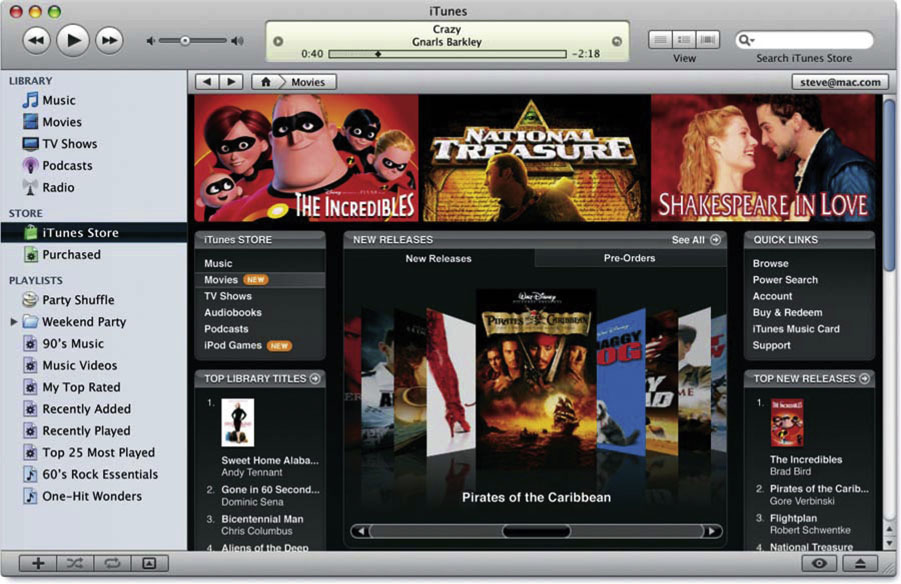10 Distribution
There are millions of people on this planet with great ideas, but only a handful ever execute them. Distribution is the final step in a long process that many people don’t ever finish. If you’re ready to distribute your project, then whether you think it came out good or not good, you should be proud of yourself for having completed it.
A film or video can be distributed in many ways and many forms. In the past, studios controlled most theatrical-distribution outlets. At the same time, getting on television or into home-video stores was almost as difficult, if not impossible. Thankfully, it is far easier to get your material out there in the world we now live in. To help understand not just where your options are, but also where they are going to be in the coming years, here’s a little history of distribution.
In 1938, the Supreme Court of the United States decided that film studios represented a monopoly. Imagine a world where only one studio’s films could play in theater chains — chains owned by that one studio. Eventually, the ruling led to the independent distributors that operate today. In the past, these distributors would have considered only big-studio features and the occasional independent film that popped up on their radar. Today, however, there are countless new technology-driven distribution opportunities emerging each day. In addition, with an estimated 2007 U.S. box office revenue of $10.16 billion1 and growing annually, never has the public been so financially and socially engaged in this industry.
Distribution companies can no longer afford the luxury of wearing horse blinders to the small projects being developed every day. From action-sports documentaries to independent films with action-sports themes, many of which are being shot on prosumer-level gear, the chance for your project to make it into theaters is more realistic than ever.
Illustration 10-1 The process from home video to theater has never been so easy.

Various online-distribution opportunities have changed the options you’ll have. Large companies such as Netflix and Blockbuster have begun opening their doors to “cold call” submissions. If you’re making a small project with little or no intent of distributing it, yet you’d still like to get your video out there, then your best option may be the Internet. You can find countless avenues online for submission of your project and for having it be considered for full distribution.
In the past, top action-sports home-video distributors — for example, JustPushPlay — would review your film, get it into niche shops, and then consider pushing it to mainstream stores such as CompUSA and Best Buy. These companies are still top names in the industry for action-sports videos; however, your distribution options have now expanded.
Table 10-1 Leading distribution outlets
|
• Film festivals • Home video • Theatrical • Television • Internet |
Film Festivals
In 2001, the Sundance Film Festival saw yet another unofficial spin-off of its titanic popularity with the action-sports festival: the aptly titled X-Dance. Taking place annually in Park City alongside Sundance, Slam-dance, and a slew of others, X-Dance has gone on to become far more than just a Sundance spin-off; X-Dance quickly established itself as its own event, with quality submissions from throughout every division of the action-sports industry. The 2006 X-Dance Best Picture Award went to Full Circle, a top Freestyle Motocross documentary on X Games gold medalist Nate Adams. The documentary chronicled Nate’s incredible rise and fall and return to the top podium. In 2005, the award went to Jack McCoy’s Blue Horizon, an incredible surf film by Billabong that documented two very opposite surfers: two-time world champion Andy Irons and soul surfer Dave “Rasta” Rastovich.
As the leading action-sports festival, X-Dance has provided an outlet for many action-sports videos to shine. X-Dance has helped projects receive accolades that led to distribution deals and provided a screening ground for projects in need of a formal premiere. Like most film festivals, X-Dance is open to submissions from around the globe. If you’ve created a project and have little or no outlet for distribution, a great place to begin your research is with film festivals. You’ll also find that by attending a festival, you can get a great understanding of what’s out there and what’s on the horizon.
Figure 10-1 Park City, Utah, skyline at night, home to X-Dance Film Festival.

Photo by Todd Seligman.
Although not all projects are right for festivals, many festivals evolve in what they are looking for. There have been years when revolutionary trick videos have won at a festival, only to be followed the next year by a biographical documentary. If your project is right for festivals, a good starting point would be for you to research what projects have won at those festivals in the past. It should also be noted that many action-sports festivals are available online on a centralized web site called Withoutabox.com. This site offers the ability to create one user profile for your project, and then submit that same profile easily, and for a discounted rate, to countless film festivals. Because there are a growing number of festivals all over the world, this can save you a great deal of time, as opposed to going through submissions one at a time.
All film festivals will require a screener copy of your movie on or before their final deadline. Remember to check with them to make sure you have the dates; otherwise you risk waiting another year for that festival. Some festivals will have extended deadlines, and others will even allow rough cuts to make a deadline as long as you can guarantee you’ll have your final cut ready in time if you get selected. You’ll also need to put together some basic material for a press kit. This typically consists of a brief synopsis of what your film or video is about, bios on the filmmakers and any principal actors or athletes, and possibly some photographs that might spark the interest of screeners and viewers. If you’re writing a bio and synopsis, try to make them stand out. Although festival screeners want truth and honesty, they do receive thousands of submissions, so a unique or memorable project may well get more attention than others, thus increasing your chances of getting in.
Figure 10-2 Withoutabox.com offers film-festival submissions.

There are two schools of thought on film festivals. The first is that new, small festivals are unknown, and thus worthless to the serious filmmaker. This side of the fence believes that you should spend your time and money submitting only to notable and respected film festivals. The other side of the fence argues that, although a big-festival win is better than a prize from a small festival, at the end of the day, an award is an award. The idea behind this way of thinking is that no matter how small the festival, the more you can enter, the better your odds of winning a prize — and a project with awards from a small festival is always better than a project with no awards. I often ride the fence on both of these ideas, and make judgments based on the size of my project.
Home-Video Distribution
Options for home-video distribution are more plentiful today than they’ve ever been. From analog tape to digital discs to completely digital content, here is a brief outline of the life of home video, followed by how it all pertains to realistic distribution opportunities.
VHS is an acronym for “Video Home System” and “Vertical Helical Scan.” Whatever the letters stand for, VHS is now a dying breed. The digital age has taken hold, and never have so many formats been vying for home-entertainment consideration. From single- and dual-layer DVD to Blu-ray and HD DVD, your options are growing year by year. As with all technological advances, this creates both benefits and pitfalls.
VHS’s inevitable replacement, the DVD (digital video disc, or digital versatile disc), has had a long run of popularity around the globe. This is still the standard format of choice for most content creators, although new emerging technologies will push DVD out. Even older formats such as VHS have struggled to hang on through the creation of alternative versions — such as Super-VHS, Data-VHS, and even VHS-W — that can hold analog video in high definition. Yet despite VHS’s fight for survival, the Motion Picture Association of America (MPAA) recently announced that movies will no longer be available on the older format.
Although the 1980s saw the first intense format war between JVC’s VHS and Sony’s Betamax, ultimately the longer recording time of VHS was a large contributing factor to the success of that format. This raises interesting questions when pondering the HD-format war: Sony’s Blu-ray versus Toshiba’s HD DVD. Blu-ray can hold nearly twice as much data as HD DVD (50 GB versus 30 GB, respectively). Although far more film studios back Blu-ray (see Table 10-3), many believe that as HD fully replaces DVD, Sony will have a leg up with dual-layer 50 GB titles.
Table 10-2 The evolution of home-video formats
| Format | Capacity |
| Betamax | N/A (linear tape) |
| VHS | N/A (linear tape) |
| DVD | 4.7 GB |
| Superbit DVD | 4.7 GB |
| DVD dual layer | 8.5 GB |
| HD DVD | 15 GB–30 GB |
| Blu-ray | 25 GB–50 GB |
| HVD (holographic versatile disc) | 300 + GB |
Table 10-3 Studio format support as of 2007
| Blu-ray | HD DVD |
| Paramount Pictures | Paramount Pictures |
| Warner Bros. | Warner Bros. |
| New Line Cinema | New Line Cinema |
| Columbia Pictures | Universal Studios |
| MGM | Weinstein Company |
| Disney | |
| 20th Century Fox | |
| Sony Pictures |
Although many action-sports projects are already shipping with HD playback options (see Figure 10-3), the majority of them still ship on standard DVD. This is in large part because of the low cost of DVD duplication. Some projects are even being duplicated and printed at home now. DVD duplicators that can burn 5, 10, or even 100 copies from your master have become increasingly available on resale locations such as eBay. If you own a LightScribe or an ink-jet CD/DVD printer (available in most standard electronics stores), you can even print your discs with a professional finish.
Figure 10-3 Todd Seligman shooting Danny Way at the Great Wall in HD.

If you plan to distribute low quantities of your movie among friends or even online, then this latter option may be ideal for you. Although the costs of replacement ink cartridges remain high for most printers, the overall ease of printing and burning from home can make it a great option for regular content creators.
Many content creators now opt to shoot as much HD as possible, knowing that their projects will have a greater street value with distributors if they can offer them on standard-definition (SD) DVD as well as high-definition Blu-ray and HD-DVD. If you are just now in the planning stages of shooting your project, then try contacting some distribution companies that look right for you, and ask them about their desire for HD content. This may help to shape what format you shoot and how you finish your project.
You will find that some distributors are less concerned with format and more concerned with content. If you’ve shot top athletes in a sport or have a truly compelling and unique story, then you have a leg up on getting your project distributed. These are negotiating points that you’ll want to bring up when going for the best deal. Oftentimes distribution companies will also want to know if you have plans to market the project yourself or if you have connections to get articles written about it. Although they likely have all of these connections themselves, and on some films will even spend their own dollars on advertising, anything you can bring to the table will also help to guarantee a slot in their lineup.
Illustration 10-2 DVD duplication quantities.

Home-video distribution deals will vary greatly as well, depending on the size of your project. Profit splits will usually come after any hard costs such as duplication have been recouped — and even then, the split can vary from as high as 70/30 in your favor to the exact opposite split in their favor. This latter split is more likely if your video has risks involved. Perhaps you can’t promise any promotions of the project, so the distributor will have to front all the costs of advertising. Or maybe you don’t have top riders in the video, and thus they don’t know if it’ll sell well enough to warrant doing minimum duplication requirements (typically 2,500 units). There are countless more reasons why profit splits can float far in either direction from a 50/50 deal. If you can, talk to someone who has dealt with your distribution company in the past, or do further research on the titles they’ve released, and consider how yours compares.
With all the competing formats and various unknowns regarding distribution, if you’re new to the game or just unsure of which way to invest your time and money, then consider this: just as many home players are now combo units with VHS and DVD built in, expect to see inexpensive combo HD DVD and Blu-ray players. You don’t have to make a decision on all of the technology now because it’s going to take time for these devices to truly saturate the market. DVD is still the reigning format by choice, and it’ll be some time before it goes away.
Figure 10-4 Holographic-disc technology.

Courtesy Piotr Jaworski.
HVD (holographic versatile discs) are thought to be the absolute future of media. These optical discs have a theoretical capacity of 3.9 terabytes,1 which is approximately 830 times the capacity of a DVD. Beginning with disc formats of 200 GB and 300 GB, HVDs begin shipping in 2008, but will take some time to become a staple of the industry. Whereas Blu-ray and HD DVD use blue lasers to write media to a disc, HVDs use a blue-green laser to write in a three-dimensional space in the disc. The high transfer rates and enormous storage capacities of HVDs will eventually make them ideal for the high-data-rate needs of video-content creators.
To put HVD capability in perspective, the U.S. Library of Congress has more than 130 million items in it. If scanned as text, the entire Library of Congress would fit on just six HVDs. In the world of iPods, that amounts to more than 20,000 hours of video (that’s more than two years’ worth). So when it comes to shooting, backing up, and distributing your HD content, HVD is the next logical step.
Until HVD takes off, however, a good DVD-distribution deal will help pay for your project. Because discs cost less than a dollar to duplicate in high quantity, if you’re selling them online from your own web site for $10 a copy, you stand to make some money. In major stores, most films sell for about $20, and distributors sell them to the stores for around $10 to $12 each. Subtracting the hard costs of making the DVDs, a 50/50 split would yield you around $4 to $5 each. You might make less per disc than doing it yourself, but you’ll likely be selling more discs this way.
Theatrical
It is only the occasional action-sports video that finds its way into movie theaters. Typically, these videos are documentary formatted, and feature the more popular or mainstream action sports, such as snowboarding, surfing, and skateboarding. These action-sports films are also usually accompanied by large budgets and high production value. A few top videos (see Table 10-4) to have graced the silver screen in the past decade went on to also be top sellers on DVD in the home-video market. In many ways, this is because theatrical releases have changed in goal and structure since the 1990s.
Table 10-4 Action-sports documentaries released in movie theaters

In the 1990s, most movies would gross more money in theaters than they would on home video. Today, home video far outgrosses theatrical. This is in part because so many people have surround-sound entertainment systems with high-resolution big-screen TVs. The result is that many theatrical films act as advertising campaigns for home video. Even though the prestige of getting your project into theaters still exists today, the real goal for many directors/producers is simply to get it out there, whether that means your film is seen in theaters or becomes a best-selling DVD.
Action sports, just like Hollywood movies, have been evolving and changing in the scope of what can get into theaters. Each year, movie studios are producing fewer big-budget movies for theatrical release, while simultaneously increasing the budgets of the few that they do. This is because movie theaters represent the last great outlet for pure entertainment spectacle (more on this in Chapter 12, The Future of Action-Sports Filmmaking). Big-budget, effects-laden summer movies still play better on the big screen. And this holds true for visual, high-production-value action-sports projects. Consider Riding Giants. What better place to see humans get towed in on surfboards at high speed to 50-foot waves than on the big screen? This is also true for heartwarming and compelling stories that transcend cultural niches such as action sports. In the case of Dogtown and Z-Boys, the real-life story of the birth of Venice Beach skateboarding, viewers were so intrigued by the characters and documentary footage that Hollywood hired top-name actors to portray the characters in the movie version, Lords of Dogtown.
Figure 10-5 Promotional poster for Lords of Dogtown.

If your goal is to get your film into theaters, then there are a few simple steps you’ll need to follow. First, if possible, make sure and shoot on HD or film. Theatrical screens project images that are approximately 2 K in size (see Chapter 2 for details), so you’ll need to have the highest-quality image possible to play well in theaters. Although the occasional DV film will release in theaters (such as The Blair Witch Project and 28 Days Later), the quality is noticeably degraded, and distributors will be reluctant to accept your project. Second, you’re going big now, so make sure you have every single aspect of your project cleared: from music and talent clearances to locations and appearing logos. Finally, decide if your greatest asset is that you have large-title sponsors, big-name athletes, or that unique story (the way Lords of Dogtown does).
Compelling stories that would do well at film festivals are better off going out and winning awards before you pitch distributors. If you think you have a project that is worthy of an X-Dance — or even Sun-dance — win, then you may want to hold off on trying to sell your project until after it runs the festival circuit. On the other hand, if you were able to land sponsorship or get some top-name athletes, then you will need to put a solid press kit together to send out to distribution companies. Some distributors won’t accept unsolicited material. This means that if you’re just an individual, and your project doesn’t have a sales agent or any type of representation, then you may want to consider going after an agent first. Here, the ideal way in is through a friend of a friend or any connection you can foster. A final outlet for getting your project out there is through online submissions. Various companies such as Netflix do in fact now fund and distribute some theatrical projects, so getting in with one of these companies can be a great asset.
Distribution at a theatrical level can be one of the hardest steps in content creation and exhibition. If you don’t wind up getting that hundred-screen guarantee, or even one screen, don’t sweat it. Home video really is becoming the prominent source for entertainment. The truth is, theatrical distribution for action sports can be very risky, and the last thing you probably want is for your project not to be profitable.
Television and Internet
On October 12, 2005, the Apple iTunes Store added support for buying and downloading video content. Then, on September 12, 2006, they increased the resolution of their content from 320 × 240 to the broadcast-size 640 × 480. These are major steps toward the future of home-video distribution. Once high-speed, real-time HD digital video files can be sent over the Internet on a regular basis, you and other content creators may no longer need to worry about duplication costs. It also means that some distributors of action-sports content will no longer need to worry about how many titles they take on. As a perfect example, look at online sites such as YouTube, which surpassed 6 million clips online in 2007, and was then growing at a rate of 65,000 new clips a day.
Figure 10-6 Apple iTunes 7 video library.

Courtesy Apple.
Posting your content online for downloadable and streaming file-sharing views has become the easiest way to distribute your material. File-sharing sites track view numbers. As your clip becomes more and more popular, you’ll be able to identify exactly how many people are watching it and how they’re rating it. In the past, these types of statistics were extremely difficult, if not impossible, to obtain. Using video online as an outlet to get distribution can also work today. Although the possibilities are endless, there are many approaches to doing it. Consider posting several sections of your work online to track, and later showing results to a potential investor, sponsor, or distributor. This would mean that you could create an online following through a vlog (video blog) or other site that you could use as leverage to get your next project green-lit.
Illustration 10-3 Television vs. the Internet.

In the past, the major networks controlled most of what viewers saw, but that power is shifting. The billions of dollars spent on advertising for broadcast is slowly dropping as fewer viewers tune in on a regular basis to conventional TV. With TiVo and DVRs in general, many of those who still watch TV regularly simply record their favorite shows and fast-forward past the commercials. In many respects, as the viewers shift onto the Internet, so will the advertising revenue, which will help create and spawn new Internet innovations, which will pull in more viewers, and so on. The snowball effect becomes cataclysmal as it approaches a definitive tipping point in which more viewers will be watching content online than on TV. With higher-speed bandwidth constantly developing, the Internet will eventually just absorb television as we know it today. Already, most popular TV shows have a web site where fans can watch episodes, interviews with stars, and even outtakes.
Just as filmmakers used to access footage linearly on tape and edit on tape-to-tape machines, now it’s an instant-access, all-the-time nonlinear process. In that same way, television streams linearly just like the tapes of the past. But that all-access nonlinear version of content sharing is right around the corner, and it’s the Internet. There are distribution companies that still sell shows and content to fill available television-broadcasting slots. Ironically, if you’re interested in getting your project on TV, you can look up many of these companies online.
Perhaps you’re shooting a documentary on a classic surf location, or even a ski resort with an incredible history. Then odds are, you might want to sell the broadcast rights to your video for TV, and then the home-video rights for DVD. If you have no intention of selling the rights to your project for any standard-distribution outlet, then maybe the Internet is the perfect home for it. Just know that even the toughest content encryption can and does get cracked. Programs exist to download content from YouTube and other video-sharing sites. People file-share and embed each other’s content on their own sites. These facts are important to remember because if your project enters the world as a digital file, you take the chance that the moment you put it out there, it may never come home.
Alternate Outlets
The Internet may be your best start, but if you want to make your money back on a video, then consider alternate revenue outlets. A few popular ones include repurposing your video segments as cell-phone content; selling the original footage to a stock content house; perhaps posting your video in segments on a web site for free, and then using Google AdWords or another company to place pay-per-click banner ads on your site; or even just flat-out selling the rights for your film to a production company for a flat rate.
All of these outlets and more are constantly evolving as technology changes. New cell-phone companies pop up, someone buys them, a web site spins out of it, and so on. The best way to track the changes and stay up-to-date on what’s happening is online. Popular web sites such as Digg.com and Engadget.com — and even social-bookmarking sites such as del.icio.us — all track up-to-date trends as these technologies mature. One of the first revenue-sharing web sites for online video posting, Revver.com, now has countless competitors in that field alone. There are hundreds of options that have risen out of the Internet and because of cell phones. It wasn’t that long ago that action-sports videos were being sold only on VHS. As overwhelming as it may be to have so many possibilities today, trust me — it’s a good problem to have.
